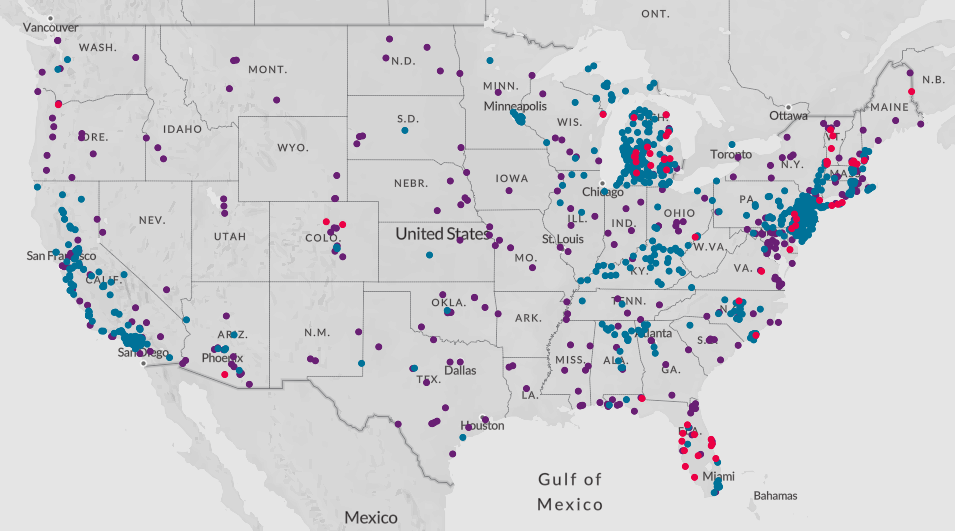There’s something in the water
They were chemicals compounds in the manufacturing process for materials such as Teflon and waterproof fabrics. But some of those chemicals – per- and polyfluoroalkyl substances – will linger in the environment and in our drinking water long after the non-stick pans and rain jackets are gone.
This class of chemicals, broadly known as perfluoroalkyl substances (PFAS), includes other synthetic compounds that were ingredients in industrial processes, such as perfluorooctanoic acid (PFOA) and perfluorooctane sulfonic acid (PFOS).
These substances accumulate in the body and are known as “forever chemicals” because they do not break down in the environment. The bioaccumulation of some of these substances may result in serious medical problems, including cancer and suppression of the immune system.

There are numerous drinking water, military, and other sites across the US that have tested positive for PFAS contamination. (Source: Environmental Working Group)
New water quality warnings, national testing, and stricter regulations are putting PFAS in the spotlight.
A study published in January 2020 by the Environmental Working Group found PFAS in tap water samples from 31 states and the District of Columbia. (Out of the 44 sample sites, only one did not test positive for PFAS.)
According to the Environmental Working Group, “The results confirm that the number of Americans exposed to PFAS from contaminated tap water has been dramatically underestimated by previous studies, both from the Environmental Protection Agency and EWG’s own research.”
IMS has noticed a spike in PFAS-related projects for testing and treatment measures. IMS covers projects from public agencies for its architectural/engineering and consulting clients, including disciplines such as water quality testing, environmental engineering, hydrology, and pollution studies. IMS provides clients with daily leads from RFPs/Qs and Advance Notices of upcoming projects.
In 2018, IMS covered just one project for PFAS testing. In 2019, there were 12 of these projects. In the first two months of 2020, IMS has already covered six PFAS-related projects.
Some recent projects IMS covered for its clients include:
* In California, the Orange County Water District released an RFP in February 2020 for a consultant to provide on-call design services for per- and polyfluoroalkyl substances treatment systems (IMS 498719-1).
About a week before the RFP was issued, the State of California lowered the acceptable levels for certain PFAS toxins in drinking water. According to The Orange County Register, the regulatory action “trigger[ed] the closure of wells throughout California — including 33 in Orange County, which has been particularly plagued by the so-called ‘forever chemical.’ As many as 29 more could be shut down this year in Orange County as the state expands its testing. If those are taken offline, that would total 71 closed wells of the 200 in Orange County Water District’s service area of 2.5 million residents.”
* In January 2020, the Yorba Linda Water District in Southern California released an RFP for an owner’s advisor for the design, construction, commissioning, and warranty period of the District’s PFAS Treatment Plant (IMS 496710). In response to the state’s new threshold levels, the Yorba Linda Water District transitioned from its groundwater sources to imported water.
* The State of Washington issued an RFP in February 2020 for the evaluation of landfill leachate samples for the presence of perfluorooctane sulfonic acid, perfluorooctanoic acid, and additional PFAS compounds (IMS 502187).
* RFPs for laboratory services to test for per- and polyfluoroalkyl substances in water samples were released in January 2020 by public agencies including the City of Columbus, Ohio (IMS 499801), the Massachusetts Water Resources Authority (IMS 497251), and the City of Warren, Michigan (IMS 496559).
Several communities are grappling with this issue in Minnesota, where testing has found a plume of contaminated groundwater in the areas around 3M’s Woodbury disposal site and the company’s Chemolite facility. (3M manufactured several products using PFAS, including Scotchgard.)

Treating sites exposed to PFAS is proving to be costly for agencies and companies alike. (Source: The Minnesota 3M PFC Settlement)
The state reached an $850 million settlement with 3M for damaging drinking water and natural resources in the southeast Twin Cities metro area. However, recent estimates put the cost of treatment at up to $1.2 billion.
According to an article in The Star Tribune: “‘Some folks may be a little surprised at the size of some of the numbers,’ said Kirk Koudelka, assistant commissioner of the Minnesota Pollution Control Agency (MPCA). ‘One of the troubling things about PFAS is there’s nothing in nature that will remove it. It got its name ‘forever chemicals’ for a good reason.’”
In December 2019, the US EPA announced new testing methods for PFAS. “’EPA’s important scientific advancement makes it possible for both government and private laboratories to effectively measure more PFAS chemicals in drinking water than ever before,’ said EPA Administrator Andrew Wheeler. ‘We can now measure 29 chemicals, marking a critical step in implementing the agency’s PFAS Action Plan – the most comprehensive cross-agency plan ever to address an emerging chemical of concern.’”
However, some argue that this does not go far enough. Environmental groups are calling for more stringent advisory limits, national standards, and “restriction on industries that use PFAS products and release the chemicals into the environment,” according to a recent Salon.com article.
IMS expects to see a growing demand for professional services to investigate, monitor, and treat water supplies that have been contaminated with PFAS. This has become a nationwide issue, with implications at the local level where we get our water. Treatment options will be studied in the coming months. There will be water quality testing for years to come. Scientists will track the health effects for decades. And communities may be living with PFAS for centuries.

